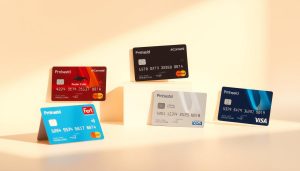In today’s fast-paced world, digital credit cards have emerged as a convenient and secure alternative to traditional plastic cards. With the rise of contactless payments and online shopping, more Aussies are turning to their smartphones instead of their wallets to manage their finances. But what exactly makes digital credit cards so appealing?
The proliferation of digital credit cards in Australia has not only streamlined the shopping experience but also enhanced it with added layers of security and personalisation. Users can now enjoy real-time transaction alerts and customised spending reports, all from the comfort of a mobile app. This blend of technology and finance is reshaping how people think about money management.
For those considering making the switch, understanding the benefits and functionalities of digital credit cards is crucial. From enhanced security features to seamless integration with digital wallets, this article will delve into everything one needs to know to navigate this evolving financial landscape. Ready to embrace the future of payments? Let’s get started!
Understanding Digital Credit Cards
Digital credit cards are essentially virtual representations of physical credit cards, allowing users to make purchases both online and in physical stores with ease. These digital versions are stored in mobile apps, which can often be part of broader digital wallets. The objective is to offer a more streamlined and secure way to handle transactions without depending on physical cards.
The appeal of digital credit cards lies in their convenience. Users can access their cards at any time via their mobile devices, eliminating the need to carry a wallet full of plastic cards. Additionally, mobile integration means that users can accomplish everything from checking their balances to making payments, all within a single app environment.
Moreover, digital credit cards provide enhanced security features such as encryption and tokenisation, which make it more difficult for fraudsters to obtain sensitive information. These features ensure that every transaction is executed with the utmost safety, offering peace of mind to users.
Benefits of Digital Credit Cards
One of the most significant advantages of digital credit cards is improved security. With encryption and tokenisation, sensitive information is less likely to be intercepted by cybercriminals. As such, digital credit cards offer a more secure way to conduct transactions compared to their physical counterparts.
Another notable benefit is the ease of tracking spending. Digital credit cards typically come with advanced features such as real-time spending alerts and detailed transaction histories, making budgeting and financial tracking more efficient. Users are empowered with better control over their financial health and are less likely to overspend.
Furthermore, digital credit cards are highly customisable. Users can set spending limits, create alerts for specific types of transactions, and even block certain merchants if needed. This level of personalisation ensures that each user can tailor their card’s functionalities to better suit their needs and lifestyle.
How to Access Digital Credit Cards
Accessing a digital credit card is a straightforward process. Most financial institutions offer digital versions of their credit cards, which can be requested through their mobile apps or online banking platforms. Once approved, the digital card can be added to a digital wallet, such as Apple Pay, Google Pay, or Samsung Pay.
To add a digital card to a smartphone’s wallet, users typically need to download the issuer’s app or access it through their digital wallet app. Once the card is set up, users can immediately start using it for online purchases, in-store transactions, or even international payments.
Importantly, it’s advisable for users to regularly update their apps and operating systems to ensure that they benefit from the latest security enhancements. Keeping the devices secure ensures that personal information remains protected at all times.
How credit card rewards really work💡
The Future of Payments
The adoption of digital credit cards marks a significant step towards the future of payments, characterised by convenience and security. As technology continues to evolve, the use of cash is expected to diminish further, making room for more digital solutions like these to dominate the market.
A growing number of retailers in Australia are now equipped to accept digital payments, reinforcing the convenience aspect for consumers. This trend is driven not only by consumer demand but also by merchants recognising the efficiency and security digital transactions can offer their businesses.
As consumer trust in digital payments increases, the use of digital credit cards is predicted to become more widespread, effectively transforming how Australians interact with money. The trend signifies a shift towards a cashless society where technology facilitates fast, convenient, and secure financial transactions.
Challenges and Considerations
While digital credit cards offer numerous benefits, they also present some challenges. One key concern is cybersecurity. Despite the strengthening of security measures, digital systems can still be vulnerable to hacks and data breaches, necessitating constant vigilance on the part of both users and service providers.
Another issue is the reliance on technology, which, while generally reliable, is not infallible. System outages or problems with mobile devices can temporarily impede access to funds. It’s crucial for users to have backup payment options to mitigate such risks.
Lastly, there is the challenge of accessibility. Not all consumers are tech-savvy or have access to smartphones required to use digital credit cards. Bridging this digital divide is essential if digital payments are truly to become ubiquitous.
Conclusion
Digital credit cards represent a transformative shift in how economic transactions are conducted in Australia. With their array of benefits, including enhanced security, real-time tracking, and seamless integration with digital wallets, it is clear why they are gaining popularity. However, as the landscape evolves, both opportunities and challenges emerge, requiring careful navigation by users and retailers alike. As the future of payments unfolds, digital solutions will likely continue to redefine financial experiences for Australians across the country.




